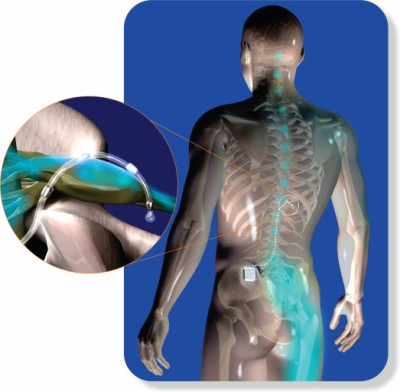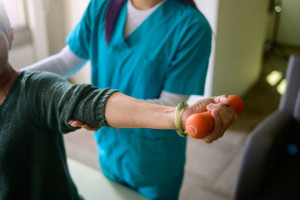Featured Treatments
 DRG Stimulation
DRG Stimulation
St. Mary’s Pain Relief Specialists were the first in the Huntington area to use the Abbott neurostimulation system that targets the dorsal root ganglion (DRG), a spinal structure densely populated with sensory nerves that transmit information to the brain via the spinal cord. This first-of-its-kind device delivers a form of spinal stimulation that can target the specific areas of the body where pain occurs. As a result, DRG stimulation gives physicians the ability to effectively provide pain relief to patients with neuropathic conditions in areas otherwise underserved by traditional spinal cord stimulation, such as the groin, lower leg and feet. DRG stimulation is also effective for patients suffering from chronic lower limb pain associated with complex regional pain syndrome (CRPS) who have previously tried multiple treatment options without receiving adequate pain relief.
NeuroSphere™ Virtual Clinic
St. Mary’s is also integrating Abbott’s NeuroSphere Virtual Clinic into its treatment model for patients currently receiving neuromodulation therapy. The first-of-its-kind remote patient care system allows a patient to both communicate with physicians and receive new stimulation treatment settings in real time anywhere with a cellular or Wi-Fi connection and a sufficiently charged patient controller.
mild®
mild is a treatment option for lumbar spinal stenosis (LSS), a condition in which the lower spinal canal narrows and compresses the spinal nerves in the lower back (Think of a kink in a drinking straw.). The mild Procedure removes excess ligament tissue to restore space in the spinal canal. The procedure typically takes less than an hour and can be performed through a single, tiny incision smaller than the size of a baby aspirin. mild is an option for those patients for which more conservative therapies, such as physical therapy or pain medications, have not provided adequate relief. LSS symptoms include pain or numbness in the lower back when standing upright.
Targeted Drug Delivery
Targeted drug delivery (or intrathecal drug delivery) uses the SynchroMed™ II infusion system to manage chronic pain. Targeted drug delivery interrupts pain pathways at their source in the cerebrospinal fluid and spinal cord. An implanted, programmable pump and catheter release prescribed amounts of pain medication directly into the intrathecal space. The benefits of targeted drug delivery include: effective pain relief, reduced or eliminated use of oral pain medicines, improved ability to function and participate in day-to-day activities, fewer side effects compared to oral medication, patient satisfaction and cost benefits.
Lumbar Radiofrequency Ablation (RFA)
A lumbar RFA is a procedure that uses radio waves to stop the lumbar media branch nerve from transmitting pain signals from an injured lumbar facet joint to the brain. Lumbar facet joints form a working motion unit that allows movement between two vertebrae. Abbott’s IonicRF™ Generator uses heat to target specific nerves and block pain signals from reaching the brain. Radiofrequency ablation has been used to treat pain, such as low back pain and Sacroiliac joint (buttocks) pain that failed to resolve with conservative treatments, such as physical therapy, injections or medication.
Spinal Cord Stimulation (SCS)
Spinal cord stimulation (SCS), or neurostimulation, is an innovative and unique treatment option used to treat a variety of pain conditions without the need for invasive surgery. Abbott’s BurstDR™ stimulation works to reduce pain by altering the pain signals as they travel to the brain, using a generator, a small device implanted in your body similar to a cardiac pacemaker. The generator sends pulses that modify the brain signals and change the way the body perceives pain. Neurostimulation may be an option for patients with: chronic pain in the back, arms or legs lasting at least six months; neuropathic pain; or patients who have found little or no relief from other treatments.
 Other treatments include:
Other treatments include:
- Physical or occupational therapy
- Psychological assessment and therapy
- Epidural steroid injections
- Peripheral nerve blocks
- Facet blocks
- Sympathetic block (lumbar sympathetic and stellate ganglion)
- Plexus blocks
- Neurolytic blocks
- Ultrasound-guided injections
- Joint injections
- Trigger point
- Botox injections
- Medication management
